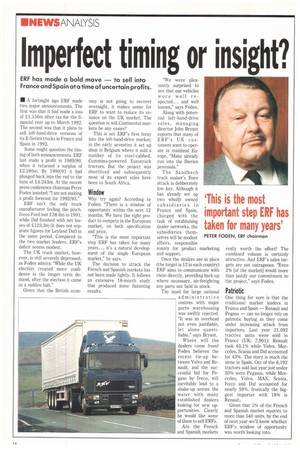Imperfect timing or insight?
Page 16

If you've noticed an error in this article please click here to report it so we can fix it.
• A fortnight ago ERF made two major announcements. The first was that it had made a loss of £1.156m after tax for the financial year up to March 1992. The second was that it plans to sell left-hand-drive versions of its E-Series trucks in France and Spain in 1993.
Some might question the timing of both announcements. ERF last made a profit in 1989/90, when it returned a surplus of £2.286m. By 1990/91 it had plunged back into the red to the tune of £4.243m. At the recent press conference chairman Peter Foden insisted: "I am not making a profit forecast for 1992/93."
ERF isn't the only truck manufacturer feeling the pinch. Iveco Ford lost £38.6m in 1991, while Daf finished with net losses of £.123.3m (it does not separate figures for Leyland Daf) in the same period. Compared to the two market leaders, ERF's deficit seems modest.
The UK truck market, however, is still severely depressed, as Foden admits: "While the UK election created more confidence in the longer term demand, after the election it came to a sudden halt: Given that the British econ omy is not going to recover overnight, it makes sense for ERF to want to reduce its reliance on the UK market. The question is will Continental markets be any easier?
This is not ERF's first foray into the left-hand-drive market; in the early seventies it set up shop in Belgium where it sold a number of its steel-cabbed, Cummins-powered Eurotruck tractors. But the project was shortlived and subsequently most of its export sales have been to South Africa.
Window
Why try again? According to Foden: "There is a window of opportunity within the next 12 months. We have the right product to compete in the European market, on both specification and price.
"This is the most important step ERF has taken for many years... it's a natural development of the single European market," he says.
The decision to attack the French and Spanish markets has not been made lightly. It follows an extensive 18-month study that produced Some flattering results. "We were pleasantly surprised to see that our vehicles were well respected... and well known," says Foden.
Along with potential left-hand-drive sales, managing director John Bryant reports that many of ERF's UK customers want to operate in mainland Europe, "Many already run into the Iberian peninsula."
The Sandbach truck maker's Euro attack is deliberately low key. Although it has already set up two wholly owned subsidiaries in France and Spain, charged with the task of establishing dealer networks, the subsidiaries themselves will be modest affairs, responsible mainly for product marketing and support.
Once the dealers are in place (the target is 12 in each country) ERF aims to communicate with them directly, providing back-up where necessary, air-freighting any parts not held in stock.
The need for large national administrative centres with major parts warehousing was swiftly rejected. "It was an overhead not even justifiable, let alone quantifiable," says Bryant.
Where will the dealers come from? Foden believes the recent tie-up between Volvo and Renault, and the successful bid for Pegaso by Iveco, will inevitably lead to a shake-up across the water with many established dealers looking for new opportunities. Clearly he would like some of them to sell ERFs.
Are the French and Spanish markets really worth the effort? The combined volume is certainly attractive. And ERF's sales targets are not outrageous. "Even 2% [of the market] would more than justify our commitment to the project," says Foden.
Patriotic
One thing for sure is that the traditional market leaders in France and Spain — Renault and Pegaso — can no longer rely on patriotic buying as they come under increasing attack from importers. Last year 21,092 tractive units were sold in France (UK: 7,901): Renault took 40,1% while Volvo, Mercedes, Scania and Daf accounted for 43%. The story is much the same in Spain. Out of the 6,192 tractors sold last year just under 30% were Pegasos, while Mercedes, Volvo, MAN, Scania, Iveco and Daf accounted for nearly 59%. Ironically the biggest importer with 18% is Renault.
Given that 2% of the French and Spanish market equates to more than 540 units, by the end of next year we'll know whether ERF's window of opportunity was worth looking into.












































































